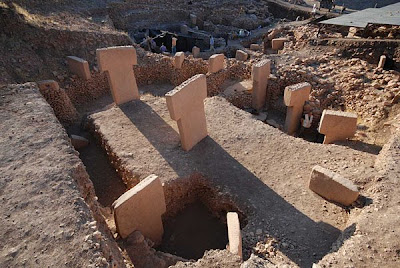






The world's oldest temple complex - built 6,000 years before Stonehenge and 7,000 years before the Egyptian pyramids - has been excavated over the last decade. Göbekli Tepe - also the earliest example of monumental architecture - was discovered in southeastern Turkey by Klaus Schmidt of the German Archaeology Institute and just might be the first thing humans ever built. It predates the formation of villages, the creation of pottery, the domestication of animals, the development of agriculture, and the invention of writing.
This "Rome of the Ice Age," as Schmidt puts it, is where hunter-gatherers met to build a complex religious community. The site features carved and polished circles of stone up to 90' wide surrounded by massive T-shaped pillars as tall as 17', with terrazzo flooring and double benches. Four of the temples and 50 of the pillars - some blank and some elaborately carved - have been uncovered to date and ground-penetrating radar reveals more than a dozen more circles. Schmidt plans to leave some of the remaining 95% of the site for future generations to excavate with more sophisticated tools. He actually rediscovered the site in 1994; it had been dismissed by American and Turkish anthropologists in the 1960s as nothing more than an abandoned medieval cemetery.
This changes everything, agree the archaeologists. It turns the idea that cities were established before religion on its head. Schmidt's theory is that it was the urge to worship 12,000 years ago that brought people together in the very first urban settings, spurred them to build and maintain this temple, and drove them to seek stable food sources and settle down to guard their new way of life. He estimates that it required at least 500 people to hew the 10- to 50-ton stone pillars from local quarries as far as 1/4 of a mile away, and stand them up. The feat would have required supervision, and suggests the existence of a priestly caste - much earlier than is evident at other Near Eastern sites.
Schmidt speculates that nomadic bands from hundreds of miles in every direction were already gathering here for rituals, feasting, and initiation rites before the first stones were cut. And the stones evidence that they came with a ready vocabulary of spiritual imagery, including animal totems of power and intelligence. The remains of the same animals depicted on the stones were found at the site, having been ritually sacrificed.
The surrounding area gave rise to the first domestication of wheat and the corralling of sheep, cattle, and pigs within the next 1,000 years, and Çatalhöyük, the oldest-known Neolithic village, is 300 miles to the west. The lack of human remains at the site is attributed to ancestor worship, which would require taking the remains to their distant homes, and the absence of traces of daily life, like fire pits and trash heaps - confirms that Göbekli Tepe was not a village. "First the temple, then the city," Schmidt concludes.









Fascinating! I hadn't heard about this at all.
ReplyDelete